The prehistoric pile dwellings around the Alps are the remains of prehistoric settlements in the lakes and moors around the Alps, the World Heritage Prehistoric Pile Dwellings around the Alps consists of 111 locations spread over six countries around the Alps: Austria, France, Germany, Italy, Slovenia and Switzerland. The prehistoric pile dwellings, also known as stilt houses or palafittes, were built between 5000 and 500 BC. The remains of the prehistoric pile dwellings provide a lively insight into the lives of early agricultural societies and development of ancient farming techniques around the Alps. Due to the rising water level most of the remains of the prehistoric wooden pile dwellings are not visible, now they only can be found underwater. The Pile Dwelling Museums houses artifacts found by archaeologists during their research. These objects mainly include pottery and tools. These objects fell into the lakes during prehistoric daily life or when the wooden pile dwellings collapsed over the course of time. In 1872, a number of prehistoric pile dwellings were discovered in the Mondsee Lake and the Attersee Lake in the Salzkammergut in Austria. The Austrian Pile Dwelling Museum in Mondsee houses a collection of pile dwelling artefacts. The museum is located in a former monastery next to the St. Michael's Church in Mondsee, the church was used for a scene in the musical The Sound of Music. Some other locations of the prehistoric pile dwellings around the Alps: Islet of Virginia in Italy and in the village of Unteruhldingen on Lake Constance in Germany. Prehistoric Pile Dwellings around the Alps were declared a UNESCO World Heritage in 2011. World Heritage Art: Palafitte
www.werelderfgoedfotos.nl © Copyright World Heritage Photos

Prehistoric Pile dwellings around the Alps: The Mondsee Lake in Austria, the remains of several prehistoric Pile dwellings were discovered in the Mondsee Lake in 1872. Due to the rising water level most of the remains of the prehistoric pile dwellings are not visible anymore, today, they only can be found underwater. The prehistoric Pile dwellings around the Alps gained the status as a UNESCO World Heritage in 2011.
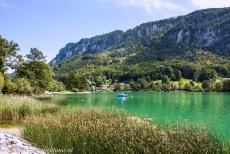
Prehistoric Pile dwellings around the Alps: The Mondsee Lake in Austria, the remains of several prehistoric Pile dwellings were discovered in the Mondsee Lake in 1872. Due to the rising water level most of the remains of the prehistoric pile dwellings are not visible anymore, today, they only can be found underwater. The prehistoric Pile dwellings around the Alps gained the status as a UNESCO World Heritage in 2011.
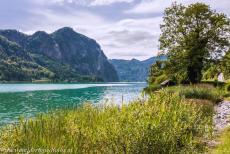
Prehistoric Pile dwellings around the Alps: Over 5000 years ago, prehistoric people built pile dwellings on the banks of the Mondsee Lake and Attersee Lake in the Salzkammergut region of Austria. Climatic changes caused an increase of the water level by 3.5 metres and therefore the prehistoric pile dwellings only can be found underwater today.
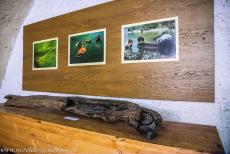
Prehistoric Pile dwellings around the Alps, Austria: The remains of a wood pole of a prehistoric pile dwelling. The Austrian Pile Dwelling Museum in the rural village of Mondsee houses several pile dwelling artifacts such as pottery and tools, the objects fell into the lakes during prehistoric daily life or when the pile dwellings collapsed over the course of time.
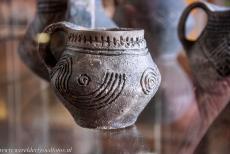
Prehistoric Pile dwellings around the Alps: Pile dwelling pottery found at the Mondsee Lake, the inhabitants of the prehistoric pile dwellings at the Mondsee Lake were famous for their pottery. Archaeologists called this self-contained culture after the Mondsee: Mondsee Culture. Objects of this outstanding cultural period are housed in the Pile Dwelling Museum in Mondsee.
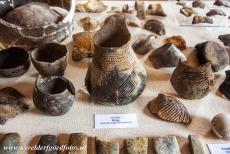
Prehistoric Pile dwellings around the Alps: The Austrian Pile Dwelling Museum is located in the tiny village of Mondsee next to the entrance of the St. Michael's Church, the museum is called: Museum Mondseeland und Österreichisches Pfahlbaumuseum. The Prehistoric Pile Dwellings around the Alps were inscribed on the UNESCO World Heritage List in 2011.
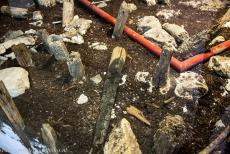
Prehistoric Pile dwellings around the Alps: The remains of the prehistoric pile dwellings provide a lively insight into the lives of early agricultural societies and development of ancient farming techniques around the Alps. The remains of the prehistoric pile dwellings in the Mondsee Lake and Attersee Lake can be found in the Pile Dwelling Museum Mondsee.
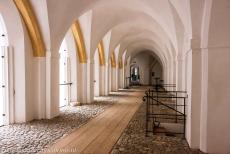
Prehistoric Pile dwellings around the Alps: The Austrian Pile Dwelling Museum is situated in a former monastery right next to the St. Michael's Church in the small village of Mondsee, the St. Michael's Church was used for a scene in the musical 'The Sound of Music' in 1965, the church was the setting for the film wedding of Maria and Georg von Trapp.
